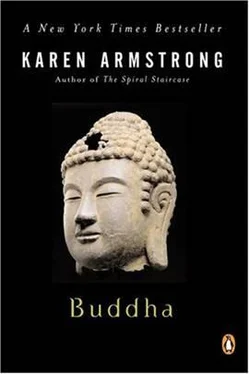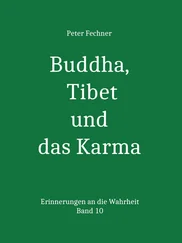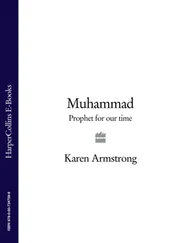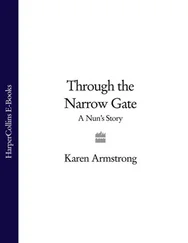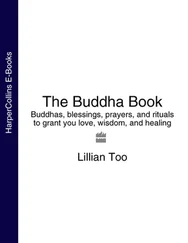The terms used in the Chain are rather obscure. “Name and form,” for example, was simply a Pali idiom for a “person”; “consciousness” ( vinnana ) is not the totality of a person’s thoughts and feelings, but a sort of ethereal substance, the last idea or impulse of a dying human being, which has been conditioned by all the kamma of his or her life. This “consciousness” becomes the germ of a new “name and form” in the womb of its mother. The personality of this embryo is conditioned by the quality of the dying “consciousness” of its predecessor. Once the fetus is linked with this “consciousness,” a new life cycle can begin. The embryo develops sense organs and, after its birth, these make “contact” with the external world. This sensual contact gives rise to “sensations” or feelings, which lead to “desire,” the most powerful cause of dukkha. Desire leads to “attachments” which prevent our liberation and enlightenment, and which doom us to a new “existence,” a new birth and further sorrow, sickness, grief and death.
The Chain begins with ignorance, which thus becomes the ultimate if not the most powerful cause of suffering. Most of the monks in the Ganges region believed that desire was the first cause of dukkha, while the Upanisads and Samkhya thought that ignorance of the nature of reality was the main bar to liberation. The Buddha was able to combine these two causes. He believed that each person is alive because he or she was preceded in a former existence by beings who did not know the Four Truths and could not, therefore, extricate themselves from Craving and Suffering. A person who was not correctly informed could make serious practical mistakes. A yogin might imagine, for example, that one of the higher states of trance was Nibbana and would not make the extra effort to achieve complete release. In most versions of the Chain given in the Pali texts, the second link is not kamma but the more difficult term sankhara (formation). But the two words both derive from the same verbal root: kr (to do). Sankhara has been somewhat clumsily translated: “states or things being formed or prepared.” Thus our deeds ( kamma ) are preparing the “consciousness” for a future existence; they are forming and conditioning it. Since the Buddha saw our intentions as mental kamma, the Chain points out that those emotions which motivate our external actions will have future consequences; a lifetime of greedy, deluded choices will affect the quality of our last, dying thought ( vinnana ) and this will affect the kind of life we have next time. Was this final, dying “consciousness” that passes into a new “name and form” an eternal, constant entity? Would the same person live again and again? Yes and no. The Buddha did not believe that “consciousness” was the kind of permanent, eternal Self sought by the yogins, but saw it as a last flickering energy, like a flame that leaps from one wick to another. A flame is never constant; a fire which is lit at nightfall both is and is not the fire that is still burning at daybreak.
There are no fixed entities in the Chain. Each link depends upon another and leads directly to something else. It is a perfect expression of the “becoming” which the Buddha saw as an inescapable fact of human life. We are always trying to become something different, striving for a new mode of being, and indeed cannot remain in one state for long. Each sankhara gives place to the next; each state is simply the prelude to another. Nothing in life can, therefore, be regarded as stable. A person should be regarded as a process, not an unchangeable entity. When a bhikkhu meditated on the Chain and saw it yogically, becoming mindful of the way each thought and sensation rose and fell away, he acquired a “direct knowledge” of the Truth that nothing could be relied upon, that everything was impermanent ( anicca ) , and would be inspired to redouble his efforts to extricate himself from this endless Chain of cause and effect.
This constant self-appraisal and attention to the fluctuations of everyday life induced a state of calm control. When the daily practice of mindfulness was continued in his meditations, it brought the bhikkhu an insight into the nature of personality that was more deeply rooted and immediate than any that could be produced by rational deduction. It also led to greater self-discipline. The Buddha had no time for the ecstatic trances of the brahmins . He insisted that his monks should always conduct themselves with sobriety, and forbade emotional display. But mindfulness also made the bhikkhu more aware of the morality of his behavior. He noticed how his own “unskillful” actions could harm other people and that even his motivation could be injurious. So, the Buddha concluded, our intentions were kamma and had consequences. The intentions, conscious or unconscious, that inspired our actions were mental acts that were just as important as any external deeds. This redefinition of kamma as cetana (intention; choice) was revolutionary; it deepened the entire question of morality, which was now located in the mind and heart and could not merely be a matter of outward behavior.
But mindfulness ( sati ) led the Buddha to a still more radical conclusion. Three days after the five bhikkhus had become “stream-enterers,” the Buddha delivered a second sermon in the Deer Park, in which he expounded his unique doctrine of anatta (no-self). He divided the human personality into five “heaps” or “constituents” ( khandhas ) : the body, feelings, perceptions, volitions (conscious and unconscious) and consciousness, and asked the bhikkhus to consider each khandha in turn. The body or our feelings, for example, constantly changed from one moment to the next. They caused us pain, let us down and frustrated us. The same had to be said of our perceptions and volitions. Thus each khandha, subject as it was to dukkha, flawed and transitory, could not constitute or include the Self sought by so many of the ascetics and yogins. Was it not true, the Buddha asked his disciples, that after examining each khandha, an honest person found that he could not wholly identify with it, because it was so unsatisfactory? He was bound to say, “This is not mine; this is not what I really am; this is not my self.” But the Buddha did not simply deny the existence of the eternal, absolute Self. He now claimed that there was no stable, lower-case self either. The terms “self” and “myself” were simply conventions. The personality had no fixed or changeless core. As the Chain showed, every sentient being was in a state of constant flux; he or she was merely a succession of temporary, mutable states of existence.
The Buddha pressed this message home throughout his life. Where the seventeenth-century French philosopher Rene Descartes would declare “I think, therefore I am,” the Buddha came to the opposite conclusion. The more he thought, in the mindful, yogic way he had developed, the clearer it seemed that what we call the “self” is a delusion. In his view, the more closely we examine ourselves, the harder it becomes to find anything that we can pinpoint as a fixed entity. The human personality was not a static being to which things happened. Put under the microscope of yogic analysis, each person was a process. The Buddha liked to use such metaphors as a blazing fire or a rushing stream to describe the personality; it had some kind of identity, but was never the same from one moment to another. At each second, a fire was different; it had consumed and recreated itself, just as people did. In a particularly vivid simile, the Buddha compared the human mind to a monkey ranging through the forest: “it grabs one branch, and then, letting that go, seizes another.” What we experience as the “self” is really just a convenience-term, because we are constantly changing. In the same way, milk can become, successively, curds, butter, ghee, and fine extract of ghee. There is no point in calling any one of these transformations “milk,” even though there is a sense in which it is correct to do so.
Читать дальше
